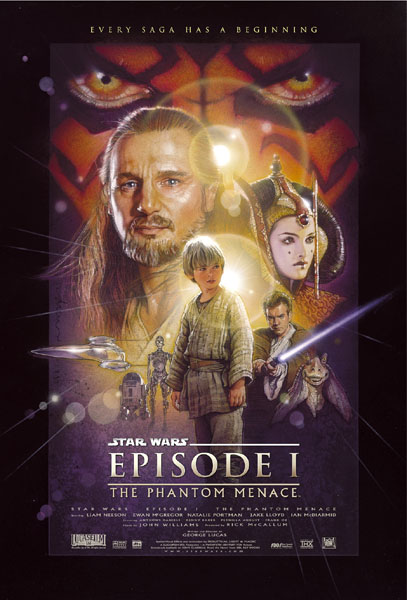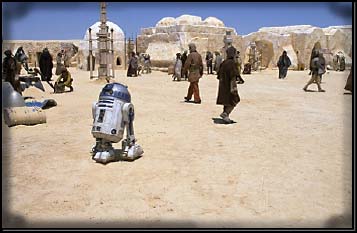
| Bad Astronomy |
|
|
|
BA Blog
|
|
Q & BA
|
|
Bulletin Board
|
| Media |
|
|
|
Bitesize Astronomy
|
|
Bad Astro Store
|
|
Mad Science
|
|
Fun Stuff
|
| Site Info |
|
|
|
Links
|
| RELATED SITES |
| - Universe Today |
| - APOD |
| - The Nine Planets |
| - Mystery Investigators |
| - Slacker Astronomy |
| - Skepticality |
Buy My Stuff

Keep Bad Astronomy close to your heart, and help make me
filthy rich. Hey, it's either this or one of those really
irritating PayPal donation buttons here.
Review: Star Wars: The Phantom Menace

NOTE! (June 7 1999) I have been informed that there are a couple of errors in my science below. This turns out to be correct. I am currently rewriting this page, but until it goes active, be aware that we do know of planets in a binary system (16 Cygni B and Rho Corona Borealis), and that double shadows are more complicated than I first supposed. They may be hard to detect by the eye. When I do some more research I'll add my comments to the pages.
Also, a brief introduction: I'll state here I like the Star Wars movies (except Return of the Jedi, yikes!) and I liked the Phantom Menace (hereafter: tPM). There wasn't a whole lot of astronomy in it, actually, so there isn't much to review. There are a few things in it worth noting, though, keeping in mind that the whole purpose of reviewing the Bad Astronomy isn't to be picky, but to make you think about what you're seeing, and to show you how things really are. Don't take any of this as a real critique of the movie. Keeping that in mind, let's get going!
Bad: In a scene from high above Tatooine, we see a fleet of Trade Federation ships silhouetted against the planet, and beyond that the sky is full of stars.
Good: This is a common scene in science fiction movies, but ask yourself a question: have you ever seen anything like it in real life? The answer is no. When NASA broadcasts live scenes from outside the Space Shuttle, you usually see the Earth in vivid blues, browns, greens and dazzling white, but you never see stars at the same time. And if you can see stars, the Earth is tremendously overexposed. The reason for this is contrast. Stars are fairly faint, while the Earth (or the Shuttle, or astronauts floating in space) are very bright. They're sitting in full sunlight!
So the Earth, when lit by the Sun, is many hundreds or thousands of times brighter than the stars behind it. When the astronauts set the camera to take pictures, they need to adjust it for that brightness. To expose the Earth correctly, they need to shut out most of the light hitting the camera, and the faint stars cannot be seen. If they adjust the camera to let in enough light to see stars (or more accurately, use a camera which amplifies the light of the stars), the Earth floods the camera with light, vastly overexposing itself. So even though the sky looks black, there will be no stars in the picture.
As a side note, I'll add that some people, remarkably, think that NASA never actually sent men to the Moon; that all the Apollo films were faked. As a piece of key evidence, they cite that all the pictures taken from the Moon have no stars in them! So instead of asking someone who might understand photography, they jump to the conclusion that NASA managed to undertake the largest conspiracy in history. This is Bad reasoning in its absolute highest form.
Bad: Tatooine orbits a binary star system. Yet in all the scenes we only see single shadows.
Good: There are three instances where we are shown that Tatooine orbits two stars. One is in the ``first'' movie, ``A New Hope''. When Luke ponders his life after his Aunt and Uncle tell him he cannot join the pilot academy, we see him watching the two suns setting in the desert. In ``The Phantom Menace'', when a starship is leaving Tatooine we get a short glimpse of two suns in the sky. Also in the movie, Anakin's mother says to him, ``You cannot stop change, any more than you can stop the suns from setting.'' Note the plural.
First, as far as we know today, it's extremely difficult to get a planet in a stable and life-supporting orbit around a binary star. Imagine a system of two stars orbiting each other, and planet also in that system. There are three types of orbits: the planet orbits just one of the stars, the planet orbits both fairly far out, or it makes a figure 8 between them. The first is highly unlikely; gravitational perturbations from the other star is likely to make a planet's orbit unstable unless the planet is very close to its primary star. Then it will be too hot to support life! The second is not so great either; in the long run (say, millions of years), such an orbit is also unstable. A planet wouldn't be able to orbit the stars long enough to support life. The third is worst of all: the planet will undergo incredibly severe seasons, with enormous temperature ranges. A figure 8 orbit isn't particularly stable either.
It's possible, I suppose, that Tatooine has no indigenous life, and was simply settled by some civilization. However, they live out in the open, with no apparent means of temperature control (the buildings never seem to have doors!), so it's unlikely that any of these orbits work anyway. To make matters worse, Tatooine is shown to have a moon in the scene described above. A moon would never be able to retain its orbit under these circumstances. After a short period of time it would get ejected from the planet due to gravitational forces of the stars.
I'll also note that these problems are theoretical; we have never actually detected a planet around a binary star, let alone charted the orbit. The Universe continually surprises us; it might again.
 Still, no matter what, why don't we see two shadows during any
of the planet surface scenes? Two suns in the sky means two shadows;
stand near two street lights at night and you'll see the
same thing. Lucas paid a lot of attention to some details in tPM,
and it surprises me he left that one out!
Still, no matter what, why don't we see two shadows during any
of the planet surface scenes? Two suns in the sky means two shadows;
stand near two street lights at night and you'll see the
same thing. Lucas paid a lot of attention to some details in tPM,
and it surprises me he left that one out!
Oh, one more thing: I know I'll get email saying ``Maybe there was only one sun up at that time, or they were both so close together they cast one shadow.'' That's possible. However, the first one rules out the planet orbiting both stars far out (if that were the case, the stars would always be visible together), the most likely case for a planet in a binary star system. The second case is unlikely for a different reason: in the first movie, the stars look to be about the same apparent size in the sky. So either one is much bigger and much farther away than the other, or they are roughly the same size and distance from the planet. Either way, that implies the planet orbits both stars far out, again meaning both should be in the sky at the same time. Having the two stars line up so close that both shadows merge into one would only happen twice an orbit (when the two stars and the planet all fall roughly in a line). It's unlikely that we happen to have all the events happen at just the right time for this to occur. No matter how you look at it or how much you try to rationalize it, Lucas just plain old made a mistake here.
Bad: After Anakin is brought aboard Queen Amidala's ship. He is cold. Padme, the Queen's handmaiden, says to him, ``You are from a hot planet, and space is cold''.
Good: This depends on how you define ``space''. Space itself has no temperature! You need to have something there to be hot, and space is technically a vacuum. However, if you had a thermometer out in space, you would actually register a temperature. In that case, it depends on where you are. Near a star, space is pretty hot! Far from a star, the temperature can get very cold, as low as about 3 degrees above absolute zero. It's hard to get colder than that because the Universe itself radiates at that temperature, so no matter where you are you'd feel at least that tiny amount of heat (there are rare special places that do get colder than that, but that's getting nitpicky). I should point out that heat and temperature are really two different things, and I urge you take a moment and read one of my Bitesize Snacks I wrote on that topic.
Good: After the pod race, Qui-Gon tends to Anakin's cut. Anakin, who has dreamed of leaving Tatooine, looks up at the stars and says, ``There are so many of them! Do they all have planet systems?'' Qui-Gon looks up as well, and slyly smiles. ``Most of them,'' he replies.
Ah, I like this one. Qui-Gon is most likely right. As recently as ten years ago, we knew of no other planets outside our solar system, and all we could do was speculate on how many there were. Now we know of over a dozen. Most of these are solitary giant planets orbiting close in to their parent stars, but in early 1999 a three planet system was found as well. The remarkable thing about that system is that it's only 44 light years away, which is right next door on the scale of the Milky Way. It's usually dangerous to extrapolate, but it's easy to imagine that if one planetary system is so close, the Galaxy must be littered with them.
So perhaps in one sense George Lucas got it exactly right: the Galaxy (even one far, far away) may have millions or even billions of planets, waiting for us to explore them. In my mind, that's one of the greatest and most exciting dreams of all.
Looking for Star Wars links? Doing a web search on ``Star Wars'' will net you about a thousand sites. Here are some good ones:
- The most obvious is
www.starwars.com. It has
lots of info, and good links too.
- Another I liked was theforce.net.
It has lots of current news about the series.
This page last modified
|
|
 |